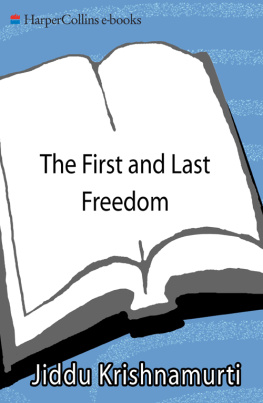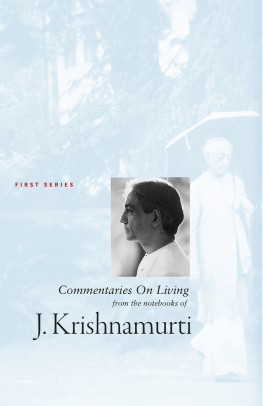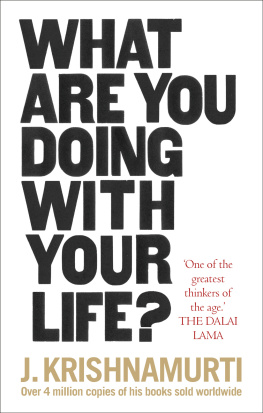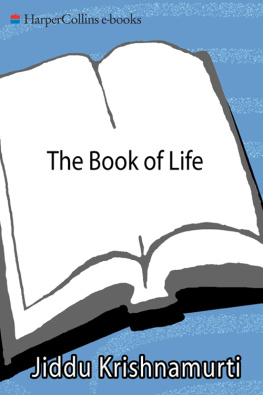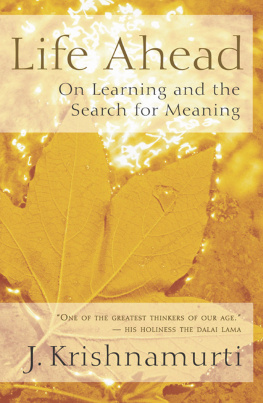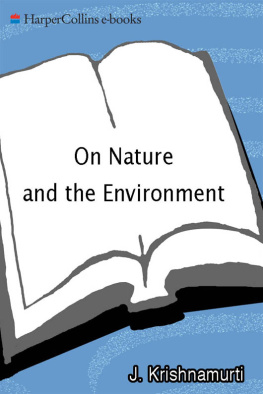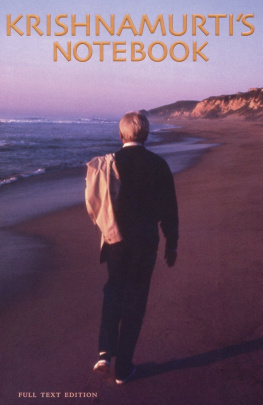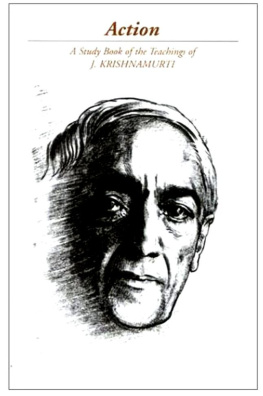Krishnamurti - The Future Is Now
Here you can read online Krishnamurti - The Future Is Now full text of the book (entire story) in english for free. Download pdf and epub, get meaning, cover and reviews about this ebook. publisher: Harper & Row, genre: Religion. Description of the work, (preface) as well as reviews are available. Best literature library LitArk.com created for fans of good reading and offers a wide selection of genres:
Romance novel
Science fiction
Adventure
Detective
Science
History
Home and family
Prose
Art
Politics
Computer
Non-fiction
Religion
Business
Children
Humor
Choose a favorite category and find really read worthwhile books. Enjoy immersion in the world of imagination, feel the emotions of the characters or learn something new for yourself, make an fascinating discovery.

- Book:The Future Is Now
- Author:
- Publisher:Harper & Row
- Genre:
- Rating:5 / 5
- Favourites:Add to favourites
- Your mark:
- 100
- 1
- 2
- 3
- 4
- 5
The Future Is Now: summary, description and annotation
We offer to read an annotation, description, summary or preface (depends on what the author of the book "The Future Is Now" wrote himself). If you haven't found the necessary information about the book — write in the comments, we will try to find it.
The Future Is Now — read online for free the complete book (whole text) full work
Below is the text of the book, divided by pages. System saving the place of the last page read, allows you to conveniently read the book "The Future Is Now" online for free, without having to search again every time where you left off. Put a bookmark, and you can go to the page where you finished reading at any time.
Font size:
Interval:
Bookmark:
The Future Is Now
Copyright 1989 by Krishnamurti Foundation Trust, Ltd.
THE FUTURE
IS NOW
Last Talks in India
J. KRISHNAMURTI
CONTENTS
Varanasi
Rishi Valley
Madras
INTRODUCTION
It was Krishnamurtis last journey to India. He had already stated at Saanen, Switzerland, that there would not be any more talks there; and he had written to a friend:
We have had the most marvellous four days of weather, sunny every day and the valley is telling us goodbye.
During the last talk at Saanen he retold the story of Nachiketa, the boy who had been sent to the house of Death for asking too many questions. It was an ancient Indian tale, from the Kathopanishad, but Krishnamurtis version was differentmore romantic, set in an ideal time when men kept their word and periodically gave away what they had accumulated. These details are not in the original, which does not have a romantic tone.
Krishnamurtis Nachiketa is full of impossible questions; he is naive, but sufficiently astute to reject the temptations Death offered with a simple observation, You will be at the end of it. You will always be at the end of everything.
Except that he was nearly 91, Krishnamurti was not very different from the Nachiketa he described. He had Nachiketas gift for turning every occasion into a question, even a boon; he had Nachiketas easy way with death; and he had Nachiketas innocent generosity.
Krishnamurtis father in his reminiscences, recorded soon after Krishnamurti had been brought into the fold of the Theosophical Society, described an innocent generosity his son never lost:
In the morning when beggars come to the house, it is our custom to send out to them a cup or bowl of unboiled rice, and we distribute it to the hands outheld in turn, until the cup is empty. My wife would send Krishna out to give alms, and the little fellow would come back for more, saying he had poured it all into one mans bag. Then his mother would go with him and teach him how to give to each.
In later life, the innocent man and the sage lived together. The man had come to India in October 1985 after talking at Saanen and at Brockwood Park, England, to say goodbye to the familiar landscape, to the people he had known and to places he had nurtured. He had also come to set his house in order.
Large educational institutions had grown at Rishi Valley and Rajghat on land which had been bought for his use by Mrs Annie Besant in the twenties. There were schools in Bangalore, Madras and Bombay, dedicated to exploring his teachings in an educational context. All these educational institutions were part of the Krishnamurti Foundation, India, a registered body of which he was president. Vasanta Vihar, a house at Adyar in Madras, was the headquarters of the Foundation and the address he used on his passport where it said home address. There were foundations in England and America also with well established educational institutions.
Krishnamurti was also the man who in 1929 had dissolved the Order of the wealthy organization which had grown around him since 1909, when he had been discovered by the Theosophists. Then he had declared Truth cannot be organized, and relinquished the properties which went with this organization.
The seeming contradiction between the man who rejects spiritual organizations and the man who at the end of his life finds himself at the head of several was resolved as long ago as 1929, when he ended that famous speech dissolving the Order:
But those who desire to understand, who are looking to find that which is eternal, without beginning and end, will walk together with greater intensity, will be a danger to everything which is unessential, to unrealities, to shadows. And they will concentrate, they will become the flame, because they understand. Such a body we must create, and that is my purpose. Because of that true friendship ... there will be real cooperation on the part of each one. And this not because of authority.
Krishnamurtis passionate concern, especially as he grew older and concerned about the health of the organizations he had himself established, was to create such a body of friends. At the same time his standards for friendship remained exacting: friendship could not flourish where there was envy, comparison, possessiveness. Only an abiding goodness, he believed, could hold people together. And the fruits of goodness were magical.
Sitting at the breakfast table one morning at Rishi Valley in the winter of 1984, in the middle of a trivial conversation, he asked us, If an angel told you that you could have anything you wanted for this place, what would you ask for?
We mentioned several thingswater, a new culture, a new mindhalf-heartedly, knowing that our answers had been trotted out to satisfy the moment, knowing that they would be brushed aside. He did just that and continued, When we came here in 1926 our intention was to establish places for the enlightenment of man. Is this happening here?
Again it was a difficult question; we admitted it was not happening.
Is Rishi Valley then exactly like the world outside? We said that it was a microcosmwe had the same problems on a smaller scale.
Answer carefully, he said. The outside world is war, deep resentment, strife, envy. Do you have these here? In you?
We replied that though these things were not active in us, the seeds were there, and, given the situation, we might be capable of that also.
He asked us if we could wipe all that out.
If we wiped that out, would the angel give us what we want?
He said simply, Yes.
Krishnamurti arrived in New Delhi from London on the 25 October and proceeded shortly thereafter to Varanasi. Aravindan, the noted film-maker from Kerala, was finishing The Seer Who Walks Alone, based on Krishnamurtis life. In early November, with winter just setting in, Rajghat, in Varanasi, provided the framework for his film, with shots of the lone fisherman casting his net on a placid river; a bird flying in a wide arc over space which was both sky and river; and the setting sun becoming a halo for the sage who said: Man is not the measure of himself.
Krishnamurti walked with Aravindan along the ancient pilgrims path, now asphalted and much abused by lorries, as it led to the banks of the Varuna. He went across the temporary bamboo bridge to the other shore where the pilgrims path, now narrow and dusty, surrounded by winter wheat, offered a glinting view of the Ganga [Ganges] and continued on to Sarnath. Here the Buddha had first preached his sermon 2,500 years ago. Aravindans camera caught Krishnamurtis return journey across the bridge with the boatman who ferried men and animals to the other shore of the river during the monsoon when the bridge was down.
There was another path he walked every day, even when his legs had begun to fail himalong the winding path of the school campus, past the amphitheatre where students of the Vasanta College had recently performed a play on the life of the Buddha. The path ended in a steep flight of steps below which lay the circular playground and, set apart on one side with a wire fence, a mosque with its lounging caretaker. Along a ridge at the bottom of the steps a narrow path led off to the officers graveyard, long in disuse, and the site now of guest cottages for the new centre to be set up for those seriously interested in studying Krishnamurtis teachings.
Krishnamurti circled round the playground several times with friends, talking of many things, but chiefly of the questions which were of vital concern to him now: What would happen to the many institutions he had established? Would they fly apart without someone to hold them together? What was the future of the Foundations? And every time he completed a circle, he would greet the caretaker of the mosque, not wanting him to feel isolated, cut off.
Next pageFont size:
Interval:
Bookmark:
Similar books «The Future Is Now»
Look at similar books to The Future Is Now. We have selected literature similar in name and meaning in the hope of providing readers with more options to find new, interesting, not yet read works.
Discussion, reviews of the book The Future Is Now and just readers' own opinions. Leave your comments, write what you think about the work, its meaning or the main characters. Specify what exactly you liked and what you didn't like, and why you think so.

